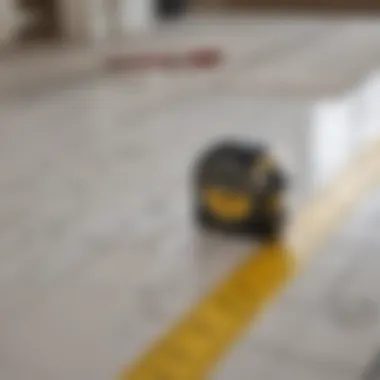Calculating Square Feet: A Complete Guide


Intro
Accurate square footage calculations are crucial in various fields such as real estate, architecture, and interior design. Understanding how to interpret floor plans is essential not only for property evaluation but also for effective space management. When one delves into floor plans, it becomes evident that different architectural styles and unique design elements can significantly influence measurements. This guide is designed to equip real estate enthusiasts, travel lovers, and interior design aficionados with the knowledge needed to calculate square footage with confidence and precision.
Featured Homes
Architectural Styles
When it comes to calculating square footage, recognizing various architectural styles is key. Each style presents its own unique elements, often affecting the overall layout. For instance, a ranch-style home typically features a single story with a simpler layout, making it easier to measure. On the other hand, Victorian and contemporary homes may include multiple levels, bay windows, and intricate designs, requiring a more nuanced approach to measurement.
Most homes fall into a few typical categories:
- Ranch Homes: Often spacious, these single-story structures allow for straightforward computation of square footage.
- Colonial Styles: Two or more stories, often symmetrical, requiring attention to height and width.
- Modern Designs: Unique angles and open concepts complicate measurement but provide more usable space.
Unique Design Elements
Certain design elements add complexity to the calculation of square footage. Features such as alcoves, projections, and open-plan layouts can complicate both interpretation and measurement. Furthermore, recognizing the difference between gross square footage and usable square footage can impact both design and valuation.
In architectural terms, unique elements include:
- Recessed Areas: These areas may not contribute to usable space but need to be accounted for in overall calculations.
- Mezzanines and Loft Spaces: These can enhance the feel of a space yet complicate measurements due to varied ceiling heights.
"Understanding how square footage influences value can make a significant difference in real estate negotiations."
Equipped with awareness about these aspects, one can more accurately interpret floor plans. This foundation allows for more informed decisions in purchasing or designing homes, making knowledge of square footage calculation every bit as critical as it is straightforward.
Understanding Square Feet
Understanding square feet is fundamental in various sectors, especially real estate and architecture. The ability to calculate this area precisely has multiple implications, from aiding in property evaluations to informing design decisions. In this comprehensive guide, the focus on square feet complements the overarching theme of accurate measurements in floor plans. It is crucial to note that square footage not only reflects the size of a space but also influences how space is utilized in practical terms.
Definition of Square Feet
Square feet is a unit of area measurement that quantifies how much space a surface covers. It is defined as the area of a square with sides that are each one foot long. Therefore, when people refer to square feet, they are typically talking about the total area within the confines of a given space, such as a room or an entire floor of a building.
In practical use, square footage helps various stakeholders, including homeowners, investors, and architects, to gauge the dimensions of living or working environments. It plays a critical role in property listings, where it often serves as a determining factor in pricing and desirability.
Importance of Accurate Measurements
Accurate measurements of square footage carry significant weight in both real estate and design. Miscalculations can lead to serious consequences, affecting sales and purchase decisions, as well as construction plans. For instance, if a property is marketed with inflated square footage, it may mislead potential buyers. On the other hand, undervaluing a space due to improper measurements can also result in financial losses.
Another aspect to consider is how precise measurements can ensure compliance with local regulations and standards. Building codes often dictate minimum space requirements for functions such as housing, commercial units, and public facilities. Clear understanding and application of square feet can also enhance design flexibility, allowing for better allocation of space, which is especially pertinent in interior design.
Accurate measurements can save time and resources during both buying and planning processes. When square footage is misunderstood or misrepresented, it can lead to conflicts and disappointment.
Basics of Floor Plans
Understanding floor plans is essential for anyone involved in real estate, architecture, or interior design. A floor plan serves as a blueprint for representing the spatial layout of a space. It gives a clear view of how individual areas interact within a larger environment. By grasping the fundamentals, one can appreciate the benefits and considerations behind floor plans, which include improving efficiency, enhancing functionality, and ensuring accurate square footage calculations.
Components of a Floor Plan
A floor plan consists of several critical components that define the structure and usability of a space. These elements include:
- Rooms and Spaces: Each room is represented in a standardized shape, clearly indicating its dimensions and usage. For example, bedrooms, bathrooms, and living areas have distinct representations.
- Doors and Windows: The placement of doors and windows affects natural light and flow within the space. Their locations are marked on the plan, which helps in understanding the overall functionality of the layout.
- Walls: The thickness and materials of walls can alter acoustics and heat retention. Wall placement is vital for recognizing how sound and energy circulate through a building.
- Furniture Layout: Some floor plans include furniture placement, offering insight into how spaces can be utilized effectively.
- Dimensions and Scale: Accurate measurements of each component ensure that the space is correctly interpreted. This information is crucial for calculating square footage.
Understanding the components of a floor plan equips professionals with the knowledge to assess usability and design properly. Each element should be analyzed to determine its impact on the overall architecture.
Types of Floor Plans
Floor plans can vary significantly based on their purpose and complexity. Familiarizing yourself with the different types is crucial for selecting the right one for your needs:
- Architectural Floor Plans: These detailed plans provide a comprehensive view of a building's interior layout and are used during the architectural design phase.
- Real Estate Floor Plans: Typically used in marketing properties, these plans give potential buyers a visual representation of the space. They focus on measurements, room layout, and functionality.
- Landscape Floor Plans: These focus on outdoor spaces. They illustrate the arrangement of gardens, patios, and other landscaping elements.
- Electrical and Plumbing Plans: These specialized plans detail the placement of electrical and plumbing systems within a structure, crucial for construction and renovation projects.
- 3D Floor Plans: These modern representations provide a more interactive view. They help visualize how a space looks in three dimensions, greatly assisting in design decisions.
"A well-designed floor plan is not just a layout; it influences the entire functionality of a space."


For additional resources, you can visit Wikipedia or Britannica.
In future sections, we will explore the preparation needed for calculating square feet and delve deeper into practical measurement techniques.
Preparing to Calculate Square Feet
Calculating square feet from floor plans is a method that lies at the foundation of architectural planning and real estate assessment. Before embarking on an accurate measurement journey, it is critical to prepare properly. Proper preparation can ensure your calculations are reliable and reflective of the space's true dimensions. This section emphasized the necessity of preparation by highlighting the essential tools required and the right measuring techniques that lead to precise outcomes.
Gathering Necessary Tools
To accurately calculate square footage, adequate tools must be at your disposal. The right tools can significantly enhance the accuracy of your measurements. Some of the essential tools include:
- Measuring Tape: A flexible measuring tape is fundamental. It provides the accuracy needed for both small and large spaces.
- Laser Distance Measurer: For more complex areas, a laser distance measurer can provide instant results with a higher degree of precision.
- Graph Paper or Design Software: Graph paper can help sketch dimensions. Alternatively, design software allows for easy manipulation and digital accuracy.
- Calculator: A simple calculator can help avoid potential errors when doing calculations, especially when converting between measurements.
Acquiring these tools before starting the measurement is a fundamental step. It not only saves time but also minimizes the frustration that arises from missing equipment during the measurement phase.
Measuring Techniques
With tools in hand, knowing how to measure correctly becomes vital. Effective measuring techniques depend on understanding what to measure and how best to approach it. Here are key techniques to consider:
- Standard Measurements: Begin measuring at one corner of the room or space and extend to the opposite end. This involves measuring both the length and width of each room. Then apply the formula for area:
- Consider Wall Thickness: Remember to include wall thickness in your calculations, particularly if the floor plan reflects exterior walls. Neglecting this can lead to inaccurate interpretations.
- Break Down Irregular Spaces: For rooms that are not standard rectangles, divide the space into manageable sections. Measure each section individually and sum the areas to get the total square footage.
- Maintain Consistency: Keep your measurements consistent in either metric or imperial but do not mix them. This approach simplifies conversion calculations later.
- Double-Check Measurements: After measuring, it is advisable to cross-verify the numbers. Misunderstandings can occur, and identifying discrepancies early helps capture correct data.
Area = Length x Width
By implementing these measuring techniques, you can ensure that the square footage derived from any floor plan is reflective of the actual space, providing valuable information for planning and evaluation.
Step-by-Step Calculation Process
Calculating square feet is not only a mathematical task but also a crucial step in space planning and evaluation. This process helps in determining usable space, affects property valuation, and guides design decisions. Understanding the step-by-step calculation process is essential for anyone involved in real estate, architecture, or interior design.
Identifying Individual Spaces
Before any calculations begin, it is vital to identify each distinct space within the floor plan. This involves reviewing the layout thoroughly to define rooms, hallways, and any other usable areas.
- Examine the Layout: Assess the drawing and recognize all enclosed areas. Each room or section must be accounted for.
- Consider Multi-Function Spaces: Spaces like living rooms that bridge multiple functions should be classified appropriately based on their primary use.
- Utilize Reference Points: Dimensions indicated on the floor plan provide a guideline. Ensure to pay attention to these when identifying rooms, as they can help confirm boundaries of each area.
Proper identification of spaces prevents confusion during calculations and helps ensure accuracy.
Applying the Measurement Formula
Once individual spaces are identified, the next step is to apply the measurement formula. The standard formula for calculating square footage is:
Length x Width = Square Feet
Here’s how to effectively apply it:
- Measure Each Area: Using the measurements provided on the floor plan, note the length and width of each room. If it is not provided, consider using a tape measure for precise determination.
- Apply the Formula: For each identified space, multiply the length by the width. This method works well for rectangular or square rooms. For example, if a room measures 12 feet by 10 feet, the calculation will be 12 x 10 = 120 square feet.
- Record Results: Keep an organized record of the square footage for each space. This can be helpful for future reference or if you need to revisit the figures.
The formula is straightforward but requires attention to detail to ensure that each measurement is taken accurately.
Calculating Total Square Footage
After obtaining the individual space measurements, aggregating them will yield the total square footage of the property. This step entails adding together the square footage of each area:
- Sum All Values: Add up the square footage from each individual space identified.For example:The total square footage would be: 120 + 80 + 150 = 350 sq. ft.
- Adjust for Common Areas if Necessary: If calculating for properties like apartments, consider whether common areas need to be included in your total.
- Living Room: 120 sq. ft.
- Kitchen: 80 sq. ft.
- Bedroom: 150 sq. ft.
Remember, accuracy in this stage can heavily influence property valuation and management decisions.
The final calculation represents a crucial figure that impacts various aspects of real estate. From selling or purchasing property to planning interior spaces, total square footage remains a fundamental measurement.
Dealing with Irregular Shapes
When dealing with square footage calculations, understanding how to approach irregular shapes is essential. Most floor plans are not composed solely of rectangles or squares. Incorporating irregular shapes requires special attention to detail. Failure to account for these shapes accurately can lead to significant discrepancies in total area calculations. This is especially important in real estate, where precise measurements influence property value and usability. Using a systematic approach helps ensure that even complex layouts are measured correctly and efficiently.
Divide and Conquer Method


The Divide and Conquer method is a practical strategy for managing irregular shapes. This technique involves breaking down a complex area into smaller, more manageable sections. Here’s how to implement this method:
- Identify the Shape: Look carefully at the layout and determine how it can be divided. For instance, an L-shaped room can be split into two rectangles.
- Measure Each Section: Use the appropriate tools to measure each section separately. It can be helpful to record these measurements systematically to avoid errors.
- Calculate Individual Areas: Once the sections are measured, calculate the area of each using the formula (Length x Width) for rectangles or (Base x Height) for triangles.
- Add the Areas Together: Finally, sum the areas of all sections to determine the total square footage of the irregular shape.
By segmenting the space, you can ensure accuracy and reduce the likelihood of mistakes that often occur with more complicated calculations.
Calculating Area of Complex Shapes
Calculating the area of complex shapes can seem daunting. However, with an organized approach, it can be manageable. Here are some common methods:
- Triangulation: For shapes with angles and curves, dividing them further into triangles can simplify calculations. Count the base and height for each triangle and apply the triangle area formula.
- Using Grids: Overlay a grid onto the irregular shape to provide a visual aid. By counting the number of full or partial grid squares covered, you can estimate the area. This method may be less precise but can serve as a good estimate.
- Mathematical Formulas: Certain shapes have distinct formulas for area calculations. For example, for circles, use ( \textArea = \pi r^2 ). Be sure to align measurements with the appropriate formula to maintain accuracy.
Understanding these techniques not only facilitates better calculations but also enhances the overall comprehension of architectural designs. Rigorous attention to detail ensures optimal outcomes in various applications, including real estate assessments and interior design layouts.
Common Mistakes to Avoid
Calculating square footage accurately is crucial for various applications, including real estate transactions, architectural design, and spatial management. Despite the seeming simplicity of the calculations, several common mistakes can easily lead to incorrect measurements. Avoiding these errors not only increases the reliability of measurements but also enhances overall planning and decision-making processes.
Neglecting Wall Thickness
One significant mistake is neglecting wall thickness when calculating area. Many people focus solely on the interior dimensions of a room, overlooking the space occupied by the walls. This can lead to substantial discrepancies in the final square footage.
Walls have specific dimensions, and ignoring them can result in underestimating the usable area. For example, a room that measures 12 feet by 10 feet, without accounting for the thickness of the walls, may not actually present that same usable space when the measurements of the walls are factored in.
To ensure accuracy, it is important to:
- Measure the wall thickness accurately.
- Include it in your total square footage calculation.
- Recognize that each wall, especially in homes with thicker materials, can significantly affect the ultimate area.
Misinterpreting Symbols
Another frequent error is misinterpreting symbols found on floor plans. Floor plans use various symbols to represent structures, spaces, and features, but these notations can be confusing for individuals unfamiliar with architectural drawings. Misinterpretation can lead not only to incorrect measurements but also to misunderstandings about room functionalities.
Common symbols include:
- Doors: Often represented as arcs that indicate swing direction. This can affect the available layout space.
- Windows: Notations for windows may vary, and understanding their placement is vital for accurate area calculation.
- Stairs: The position and dimensions of stairs can impact how much usable space is designated.
Before commencing measurements, be sure to review the floor plan's legend or key. Familiarizing yourself with the symbols can prevent crucial misunderstandings.
Using Incorrect Units
Using incorrect units of measurement can greatly distort calculations. It is essential to remain consistent with units—whether in feet, inches, or meters. For example, if you measure a room in inches and then convert to square feet without proper conversion, the results could be drastically misleading.
Additionally, different measurement standards exist in various regions, such as metric versus imperial systems. Failure to recognize these differences can also lead to errors.
Here are measures to take to prevent unit confusion:
- Always double-check which unit is being used.
- Convert measurements accurately using well-known conversion factors.
- Stay consistent throughout the entire calculation process.
"Even small discrepancies in measurement can scale up to large errors in area calculations."
Taking the necessary precautions to avoid these common mistakes will lead to a much more accurate understanding of square footage from floor plans. Accurate measurements not only aid in effective design and layout decisions but also have profound implications on property valuation and usability.
Tools and Technology for Measuring
In modern architecture and real estate, measuring tools and technology play a crucial role in ensuring that square footage calculations are both precise and efficient. With the evolution of technology, the traditional methods of measurement have been supplemented with digital tools that enhance accuracy and reduce human error. Understanding how to utilize these tools effectively can significantly impact the design, arrangement, and valuation of spaces.
The importance of leveraging tools and technology for measuring square footage extends beyond mere convenience. Accurate measurements form the backbone of architectural integrity, directly influencing how a space functions and is perceived. Miscalculations can lead to costly mistakes, whether in construction, design, or real estate transactions. Hence, embracing available technology is not just advisable; it is imperative for anyone serious about floor planning and property evaluation.
Digital Measuring Tools
Digital measuring tools have revolutionized how professionals approach measurement tasks. Devices like laser distance measurers offer quick and highly accurate readings. These tools typically also include features that allow for easy calculation of areas and volumes, thus simplifying the overall completion of measurements.
Some key benefits of digital measuring tools include:
- Speed: Measurements that might take several minutes using tape measures can be completed in a matter of seconds.
- Accuracy: Digital tools vastly reduce the risk of human error, providing precise measurements that are essential for effective planning.
- User-friendly interfaces: These devices often come equipped with intuitive displays and instructions that make them accessible even to novices.
However, while they are beneficial, users should take into account a few considerations. First, it is important to ensure that the device is calibrated correctly. Regular maintenance of the tool is also essential to preserve its accuracy over time.
Software Solutions for Floor Planning


In addition to physical measuring tools, various software solutions have emerged to aid in floor planning and square footage calculations. Applications such as SketchUp, AutoCAD, and RoomSketcher provide users with the capability to create detailed floor plans while integrating measurement functionalities.
These software solutions offer several advantages:
- Visual representation: Creating a visual layout helps in better understanding how the space is organized, which is not always clear from a simple numerical calculation.
- Visualization of designs: Users can experiment with different layouts, helping them make informed decisions about space use and design aesthetic.
- Collaboration tools: Many software platforms enable sharing and collaborating with clients and team members, ensuring everyone is on the same page.
Nevertheless, users should be prepared for a learning curve that comes with using advanced software. A solid understanding of the software’s functionalities can be essential in unlocking its full potential. Additionally, ensuring data security, especially when dealing with client information, is a vital consideration that users must not overlook.
Overall, integrating both digital measuring tools and floor planning software into your toolkit will enhance your ability to calculate square footage accurately and efficiently. By leveraging these technologies, real estate professionals and interior designers can make informed decisions that benefit their projects and clients.
Real-World Applications
Understanding how to calculate square footage from floor plans is critical in various fields such as real estate, architecture, and interior design. Accurate square footage calculation not only influences property valuations but also impacts design and space utilization decisions. These applications extend beyond theoretical knowledge, making practical understanding essential for professionals and enthusiasts alike.
Implications in Real Estate
In the realm of real estate, the implications of precise square footage measurements cannot be overstated. When buyers and sellers negotiate, the reported square footage can heavily influence pricing. A property that is accurately described in terms of size can prevent legal disputes, provide transparency, and build trust among parties during real estate transactions.
Furthermore, real estate agents utilize square footage to present properties effectively. Listings that feature accurate square footage attract serious inquiries and can convert leads into sales more efficiently. Additionally, appraisers rely on square footage data to establish fair market values. Incorrect measurements could lead to overvalued or undervalued properties, which can harm reputations in a competitive market.
Impact on Design and Layout Decisions
The impact of square footage calculations extends deeply into design and layout decisions. Architects and interior designers use measurements to create functional and aesthetically pleasing spaces. Knowing the square footage allows for better planning of room configurations, flow, and usability. For instance, in dense urban environments, every square foot counts when optimizing layouts for homes, offices, and commercial spaces.
In addition, accurate floor measurement helps to determine the types of furnishings that fit a space. Designers can select the appropriate size and scale of furniture, which enhances both comfort and aesthetic appeal. Using incorrect measurements can lead to overcrowded or empty spaces, causing dissatisfaction among clients.
Ultimately, understanding real-world applications of square footage calculations enriches decision-making processes across the real estate and design fields, leading to more informed and successful outcomes.
Reviewing and Verifying Measurements
Reviewing and verifying measurements is a critical aspect of calculating square feet from floor plans. It ensures accuracy, which is essential for a variety of applications. In real estate, for example, an incorrect measurement might lead to misrepresented properties and, consequently, financial losses for both buyers and sellers. Interior designers also rely on accurate measurements to create functional and aesthetic spaces. Therefore, a systematic approach to verification can save time and prevent costly errors.
There are specific elements that one must consider when conducting this review. First, double-checking dimensions against the original floor plans is vital. Mistakes can occur during the initial measurement process, and catching them early can be beneficial. Secondly, the method of measurement, whether manual or using digital tools, should be assessed. Digital tools often provide higher precision, but one should still confirm their results to avoid discrepancies.
The benefits of reviewing and verifying measurements are extensive. It fosters confidence in the finalized calculations and allows for better planning of spaces. A minor error in square footage can lead to substantial implications, including zoning issues or challenges in complying with building codes. For investors and homeowners alike, accuracy translates to sound decision-making.
Conducting a Verification Process
Conducting a verification process involves a few straightforward steps. First, revisit each area measured. Use tools like a tape measure or a laser measuring device to compare the actual dimensions against the recorded ones. Be meticulous about areas like corners, which can sometimes create unexpected gaps in measurements.
Once measurements are taken, align them with the floor plan. Check each room and corridor, ensuring that the lengths and widths match those indicated. If misalignment occurs, reevaluate your initial measurements to determine where the error lies. It can be beneficial to measure twice to ensure reliability.
In addition to physical measurements, it's recommended to verify your results by calculating the total square footage. This checkpoint can catch discrepancies early in the process. Awkward spaces or unusual shapes often require careful attention.
When to Consult a Professional
There are times when consulting a professional becomes necessary. If your space is particularly intricate or large, it might be wise to seek an architect or a professional measurer. They possess experience and specialized tools to ensure accuracy, which can save considerable time and potential headaches.
Furthermore, if inconsistencies persist after your verification process, professional insight can be invaluable. An expert can offer methods to manage difficult shapes or advise on best practices for measurements that might not be apparent to an amateur.
Consulting professionals can seem like a cost, but consider this against the risk of not doing so. Accuracy in measuring is more than just a minor task; it holds significant implications for construction, design, and property valuation. Therefore, don't hesitate to seek help when needed.
Culmination
The conclusion serves as a critical point of reflection in this guide on calculating square feet from floor plans. It summarizes the vital themes discussed throughout the article, reinforcing the methodologies and principles that govern precise measurements. A careful review of measurements not only aids in property valuation but also informs design decisions that align with practical use.
When measurements are accurate, they ensure optimal usage of space and resources. They allow architects and designers to craft spaces that are not just aesthetics-based but also functional and efficient. Additionally, real estate professionals rely greatly on these measurements. Their ability to assess a property accurately influences buying, selling, and investment strategies.
In essence, the importance of accurate square footage measurements cannot be overstated. It affects multiple dimensions of space—from residential to commercial layouts—and impacts stakeholders, including buyers, sellers, and designers alike. As such, integrating these details into planning processes can yield significant long-term benefits for anyone involved in real estate or architectural design.
"An accurate understanding of space transforms how we engage with our built environments."
Summary of Key Points
- Understanding Measurements: Accurate measurements form the backbone of effective floor plan analysis.
- Employing Correct Techniques: Utilizing proper measuring tools and techniques ensures precise calculations, avoiding common pitfalls.
- Value in Accurate Planning: Accurate square footage can significantly impact real estate transactions and design outcomes.
- Importance of Verify Checks: Regularly confirming measurements can prevent costly mistakes down the line.
Encouragement for Accurate Planning
The call for accurate planning resonates across various sectors. For architects, it lays the foundation for innovative design. For real estate professionals, precise measurements are directly tied to property value. As an enthusiast or a professional in these fields, diligence in accurately calculating square footage is essential. It enhances not just the quality of work but also trust and reliability in the services provided.
Consider making it a practice to routinely evaluate and measure spaces, challenging assumptions that lead to errors. Continuous learning and adaptation of new measuring tools can foster greater efficiency in your projects. By doing so, you contribute to creating spaces that are thoughtfully designed and fit for purpose.















